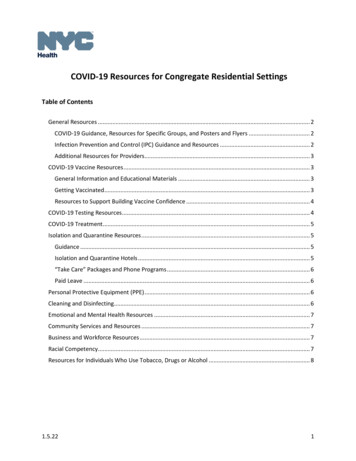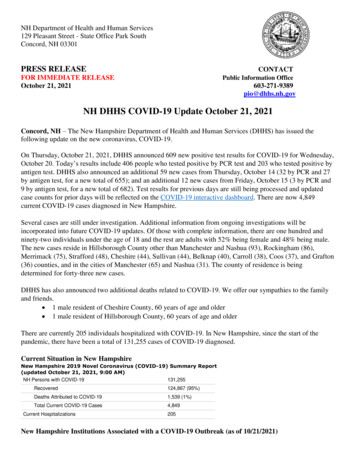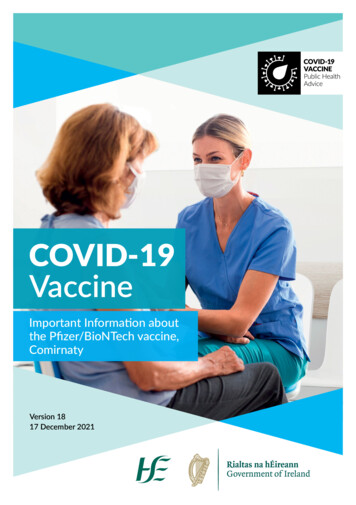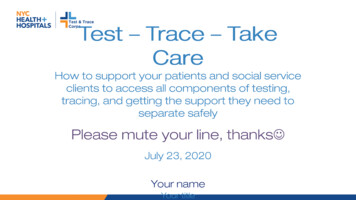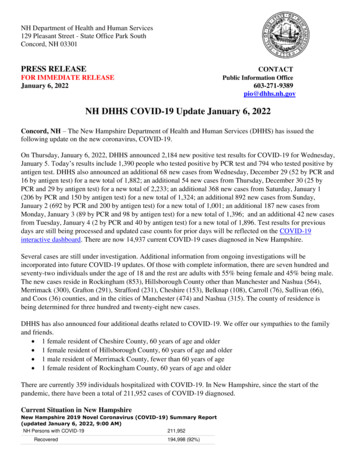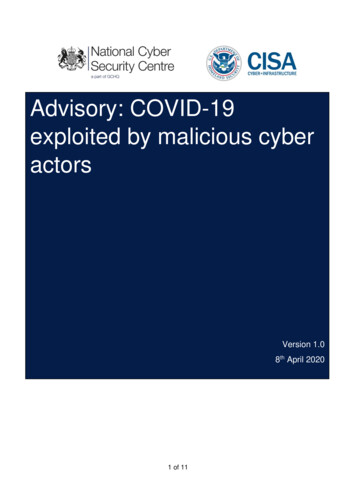
Transcription
Advisory: COVID-19exploited by malicious cyberactorsVersion 1.08th April 20201 of 11
This is a joint advisory from the United Kingdom’s National Cyber Security Centre(NCSC) and the United States Department of Homeland Security (DHS) Cybersecurityand Infrastructure Security Agency (CISA).IntroductionThis advisory provides information on exploitation by cyber criminal and advancedpersistent threat (APT) groups of the current coronavirus disease 2019 (COVID-19)global pandemic. It includes a non-exhaustive list of indicators of compromise (IOCs)for detection as well as mitigation advice.COVID-19 exploitationAn increasing number of malicious cyber actors are exploiting the current COVID-19pandemic for their own objectives. In the UK, the NCSC has detected more UKgovernment branded scams relating to COVID-19 than any other subject. Although,from the data seen to date, the overall levels of cyber crime have not increased boththe NCSC and CISA are seeing a growing use of COVID-19 related themes bymalicious cyber actors. At the same time, the surge in home working has increasedthe use of potentially vulnerable services, such as Virtual Private Networks (VPNs),amplifying the threat to individuals and organisations.APT groups and cyber criminals are targeting individuals, small and mediumbusinesses and large organisations with COVID-19 related scams and phishingemails. This advisory provides you with an overview of COVID-19 related maliciouscyber activity. It offers practical advice that individuals and organisations can follow toreduce the risk of being affected. The IOCs provided within the accompanying .csvand .stix files of this advisory are based on analysis from CISA, NCSC, and industry.Note: this is a fast-moving situation and this advisory does not seek to catalogue allCOVID-19 related malicious cyber activity. You should remain alert to increasedactivity relating to COVID-19 and take proactive steps to protect yourself and yourorganisation.Summary of attacksAPT groups and cyber criminals are exploiting the COVID-19 pandemic as part of theircyber operations. These cyber threat actors will often masquerade as trusted entities.Their activity includes using coronavirus-themed phishing messages or maliciousapplications, often masquerading as trusted entities that may have been previouslycompromised. Their goals and targets are consistent with long-standing priorities suchas espionage and information operations.Cyber criminals are using the pandemic for commercial gain, deploying a variety ofransomware and other malware.2 of 11
Both APT groups and cyber criminals are likely to continue to exploit the COVID-19pandemic over the coming weeks and months. Threats observed include: Phishing, using the subject of coronavirus or COVID-19 as a lureMalware distribution using coronavirus or COVID-19 themed luresRegistration of new domain names containing coronavirus or COVID-19 relatedwordingAttacks against newly (and often rapidly) deployed remote access or remoteworking infrastructure.Social engineering techniquesMalicious cyber actors rely on basic social engineering methods to entice a user tocarry out a specific action. These actors are taking advantage of human traits such ascuriosity and concern around the coronavirus pandemic in order to persuade potentialvictims to: Click on a link or download an app that may lead to a phishing website, or thedownloading of malware, including ransomware.o For example, a malicious Android app purports to provide a real-timecoronavirus outbreak tracker but instead attempts to trick the user intoproviding administrative access to install ‘CovidLock’ ransomware ontheir device.1Open a file (such as an email attachment) which contains malware.o For example, email subject lines contain COVID-19 related phrasessuch as ‘Coronavirus Update’ or ‘2019-nCov: Coronavirus outbreak inyour city (Emergency).’To create the impression of authenticity, malicious cyber actors may spoof senderinformation in an email to make it appear to come from a trustworthy source, such asthe World Health Organization (WHO) or an individual with ‘Dr.’ in their title. In severalexamples, actors send phishing emails that contain links to a fake email login page.Other examples purport to be from an organisation’s human resources (HR)department and advise the employee to open the attachment.Malicious file attachments containing malware payloads may be named withcoronavirus or COVID-19 related themes, such as “President discusses budgetsavings due to coronavirus with Cabinet.rtf.”Note: A non-exhaustive list of IOCs related to this activity is provided within theaccompanying .csv and .stix files linked to this ous-androidapp/3 of 11
PhishingThe NCSC and CISA have both observed a large volume of phishing campaigns whichuse the social engineering techniques described above.Examples of phishing email subject lines include: 2020 Coronavirus UpdatesCoronavirus Updates2019-nCov: New confirmed cases in your City2019-nCov: Coronavirus outbreak in your city (Emergency).These emails will contain a call to action encouraging the victim to visit a URL thatmalicious cyber actors use for stealing valuable data, such as usernames andpasswords, credit card information and other personal information.SMS PhishingMost phishing attempts come by email but the NCSC and CISA have observed someattempts to carry out phishing by other means, including text messages (SMS).Historically, SMS phishing has often used financial incentives, including governmentpayments and rebates (such as a tax rebate) as part of the lure. Coronavirus-relatedphishing continues this financial theme, particularly in light of the economic impact ofthe epidemic and governments’ employment and financial support packages.For example, a series of SMS messages uses a UK government themed lure toharvest email, address, name, and banking information. These SMS messages,purporting to be from ‘COVID’ and ‘UKGOV,’ (see figure 1) includes a link directly tothe phishing site (see figure 2).Figure 1 – UK Government themed SMS phishing4 of 11
Figure 2 - UK Government themed phishing pageAs this example demonstrates, malicious messages can arrive by methods other thanemail. In addition to SMS, possible channels include WhatsApp and other messagingservices. Malicious cyber actors are likely to continue using financial themes in theirphishing campaigns. Specifically, it is likely that they will use new governmentcompensation schemes responding to COVID-19 as themes in phishing campaigns.Phishing for credential theftA number of actors have used COVID-19 related phishing to steal user credentials.These emails will include previously mentioned COVID-19 social engineeringtechniques, sometimes complemented with urgent language to enhance the lure.If the user clicks on the hyperlink, a spoofed login webpage appears which includes apassword entry form. These spoofed login pages may relate to a wide array of onlineservices including - but not limited to - email services provided by Google or Microsoft,or services accessed via government websites.To further entice the recipient, the websites will often contain COVID-19 relatedwording within the URL (for example, ‘corona-virus-business-update,’ ‘covid19advisory’ or ‘cov19esupport’). These spoofed pages are designed to look legitimate or5 of 11
accurately impersonate well-known websites. Often the only way to notice maliciousintent is through observing the website URL. In some circumstances, malicious cyberactor specifically customise these spoofed login pages for the intended victim.If the victim enters their password on the spoofed page, the attackers will be able toaccess the victim’s online accounts such as their email inbox. This access can thenbe used to acquire personal or sensitive information, or to further disseminate phishingemails, using the victim’s address book.Phishing for malware deploymentA number of threat actors have used COVID-19 related lures to deploy malware. Inmost cases, actors craft an email that persuades the victim to open an attachment ordownload a malicious file from a linked web page. When they open the attachment themalware is executed, compromising the victim’s device.For example, the NCSC has observed various email distributed malware whichdeploys the Agent Tesla keylogger malware. The email appears to be sent from DrTedros Adhanom Ghebreyesus, Director-General of the World Health Organization(WHO). This email campaign began on Thursday, March 19, 2020. Another similarcampaign offers thermometers and face masks to fight the epidemic. The emailpurports to attach images of these medical products but instead contains a loader forAgent Tesla.In other campaigns, emails included an Excel attachment (e.g. ‘8651 8-14-18.xls’) orcontained URLs linking to a landing page that – if clicked - redirects to download anExcel document such as ‘EMR Letter.xls.’ In both cases, the Excel file contains macrosthat, if enabled, execute an embedded dynamic-link library (DLL) to install the Get2loader malware. Get2 loader has been observed loading the GraceWire Trojan.The TrickBot malware has been used in a variety of COVID-19 related campaigns. Inone example, emails target Italian users with a document purporting to be informationrelated to COVID-19 (see figure 3). The document contains a malicious Macro whichdownloads a batch file (BAT) which launches JavaScript, which - in turn - pulls downthe TrickBot binary, executing it on the system.6 of 11
Figure 3 – Email containing malicious macro targeting Italian users2In many cases, Trojans - such as Trickbot or GraceWire2 - will download furthermalicious files such as Remote Access Trojans (RATs), desktop-sharing clients andransomware. In order to maximise the likelihood of payment, cyber criminals will oftendeploy ransomware at a time when organisations are under increased pressure.Hospitals and health organisations in the United States,3 Spain4 and across Europe5have all been recently affected by ransomware incidents.As always, you should be on the lookout for new and evolving lures. Both the NCSC6and CISA7,8 provide guidance on mitigating malware and ransomware attacks.Exploitation of new home working infrastructureMany organisations have rapidly deployed new networks, including VPNs and relatedIT infrastructure, to cater for the large shift towards home working.Malicious cyber actors are taking advantage of this on this mass move to homeworking by exploiting a variety of publicly known vulnerabilities in VPNs and otherremote working tools and software. In several examples, the NCSC and CISA ware7 of 11
observed actors scanning for publicly known vulnerabilities in Citrix. Citrix vulnerability(CVE-2019-19781) and its exploitation has been widely reported online, since earlyJanuary 2020. Both the NCSC9 and CISA10 provide guidance on CVE-2019-19781and continue to investigate multiple instances of this vulnerability’s exploitation.Similarly known vulnerabilities affecting VPN products from vendors Pulse Secure,Fortinet and Palo Alto continue to be exploited. CISA provides guidance on the PulseSecure vulnerability11 and the NCSC provides guidance on the vulnerabilities in PulseSecure, Fortinet, and Palo Alto.12Malicious cyber actors are also seeking to exploit the increased use of popularcommunications platforms (such as Zoom or Microsoft Teams) by sending phishingemails that include malicious files with names such as ‘zoom-uszoom ##########.exe’ and ‘microsoft-teams V#mu#D ##########.exe’ (#representing various digits that have been reported online).13 The NCSC and CISAhave also observed phishing websites for a number of popular communicationplatforms. In addition, attackers have been able to hijack teleconference and onlineclassrooms that have been set up without security controls (e.g. passwords) or withunpatched versions of the communications platform software.14The surge in home working has also led to an increase in the use of Microsoft’sRemote Desk Protocol (RDP). Attacks on unsecured RDP endpoints (i.e. exposed tothe internet) are widely reported online,15 and recent analysis16 has identified a 127%increase in exposed RDP endpoints. The increase in RDP use could potentially makeIT systems, without the right security measures in place, more vulnerable to attack.17Indicators of compromiseThe NCSC and CISA are working with law enforcement and industry partners todisrupt or prevent these malicious COVID-19 themed cyber activities. We havepublished a non-exhaustive list of COVID-19 related IOCs via the following links: CSV file: ations/AA20099A WHITE.csv Stix File: ations/AA20099A able-disaster/ .us-cert.gov/ncas/tips/ST18-001108 of 11
In addition, there are a number of useful resources online, which provide details ofCOVID-19 related malicious cyber activity: Recorded Futures’ report, Capitalizing on Corona Panic, Threat Actors TargetVictime worldwideDomainTools’ Free COVID-19 Threat List – Domain Risk Assessments forCoronavirus ThreatsGitHub list of IOCs used in COVID-19 related cyberattack campaigns, gatheredby GitHub user, Parth D. ManiarGitHub list of Malware, spam, and phishing IOCs that involve the use ofCOVID-19 or coronavirus gathered by SophosLabsReddit master thread to collect intelligence relevant to COVID-19 maliciouscyber threat actor campaignsTweet regarding the MISP project’s dedicated #COVID2019 MISP instance toshare COVID-related cyber threat informationConclusionMalicious cyber actors are continually adjusting their tactics to take advantage of newsituations, and the COVID-19 pandemic is no exception. Malicious cyber actors areusing the high appetite for COVID-19 related information as an opportunity to delivermalware and ransomware and to steal user credentials. Individuals and organisationsshould remain vigilant. For genuine information about the virus, please use trustedresources such as the UK government website18, Public Health England19 or NHSwebsites20.Mitigating the riskFollowing the NCSC and CISA advice set out below should help mitigate the risk toindividuals and organisations from malicious cyber activity related to both COVID-19and other themes: NCSC guidance for the public to help them spot, understand and deal withsuspicious messages and -email-actionsNCSC phishing guidance for organisations and cyber security shingNCSC guidance on mitigating malware and ransomware g-malware-and-ransomwareattacksNCSC guidance on home working: /www.nhs.uk/conditions/coronavirus-covid-19/199 of 11
NCSC guidance on End User Device er-device-security/eudoverview/vpnsCISA guidance for defending against COVID-19 cyber scams: 03/06/defending-against-covid-19-cyberscamsCISA Insights: Risk Management for Novel Coronavirus (COVID-19), whichprovides guidance for executives regarding physical, supply chain, andcybersecurity issues related to publications/20 0318 cisa insights coronavirus.pdfCISA Alert (AA20-073A) on enterprise VPN security: https://www.uscert.gov/ncas/alerts/aa20-073aCISA website providing a repository of the agency’s publicly available COVID19 guidance: https://www.cisa.gov/coronavirusPhishing guidance for individualsThe NCSC’s suspicious email guidance explains what to do if you've already clickedon a potentially malicious email, attachment or link. It provides advice on who tocontact if your account or device has been compromised and some of the mitigationsteps you can take (such as changing your passwords). It also offers NCSC’s toptips for spotting a phishing email: Authority - Is the sender claiming to be from someone official (like your bank,doctor, a solicitor, government department)? Criminals often pretend to beimportant people or organisations to trick you into doing what they want.Urgency - Are you told you have a limited time to respond (like in 24 hours orimmediately)? Criminals often threaten you with fines or other negativeconsequences.Emotion - Does the message make you panic, fearful, hopeful or curious?Criminals often use threatening language, make false claims of support, ortease you into wanting to find out more.Scarcity - Is the message offering something in short supply (like concerttickets, money or a cure for medical conditions)? Fear of missing out on agood deal or opportunity can make you respond quickly.Phishing guidance for organisations and cyber securityprofessionalsOrganisational defences against phishing often rely exclusively on users being able tospot phishing emails. However, you should widen your defences to include moretechnical measures. This will improve your resilience against phishing attacks.In addition to educating users on defending against these attacks, you should considerNCSC’s guidance for organisations that splits the mitigations into four layers, on whichyou can build your defences:1. Make it difficult for attackers to reach your users10 of 11
2. Help users identify and report suspected phishing emails (see CISA Tips, UsingCaution with Email Attachments and Avoiding Social Engineering and PhishingScams)3. Protect your organisation from the effects of undetected phishing emails4. Respond quickly to incidentsNCSC and CISA also recommend organisations plan for a percentage of phishingattacks to be successful. Planning for these incidents will help minimise the damagecaused.Communications platforms guidance for individuals andorganisationsDue to COVID-19, an increasing number of organisations and individuals are turningto communications platforms (such as Zoom and Microsoft Teams) for onlinemeetings. In turn, malicious cyber actors are hijacking online meetings that are notsecured with passwords or that use unpatched software.Tips for defending against online meeting hijacking (Source: FBI March 30, 2020press release, FBI Warns of Teleconferencing and Online Classroom Hijacking DuringCOVID-19 Pandemic): Do not make meetings public. Instead, require a meeting password or use thewaiting room feature and control the admittance of guests.Do not share a link to meeting on an unrestricted publicly available socialmedia post. Provide the link directly to specific people.Manage screensharing options. Change screensharing to “Host Only.”Ensure users are using the updated version of remote access/meetingapplications.Ensure telework policies address requirements for physical and informationsecurity.DisclaimersThis report draws on information derived from NCSC, CISA and industry sources. Anyfindings and recommendations made have not been provided with the intention ofavoiding all risks, and following the recommendations will not remove all such risk.Ownership of information risks remains with the relevant system owner at all times.CISA does not endorse any commercial product or service, including any subjects ofanalysis. Any reference to specific commercial products, processes, or services byservice mark, trademark, manufacturer, or otherwise, does not constitute or imply theirendorsement, recommendation, or favouring by CISA.11 of 11
and Infrastructure Security Agency (CISA). Introduction This advisory provides information on exploitation by cyber criminal and advanced persistent threat (APT) groups of the current coronavirus disease 2019 (COVID-19) global pandemic. It includes a non-exhaustive list of indicators of compromise (IOCs) for detection as well as mitigation advice.





